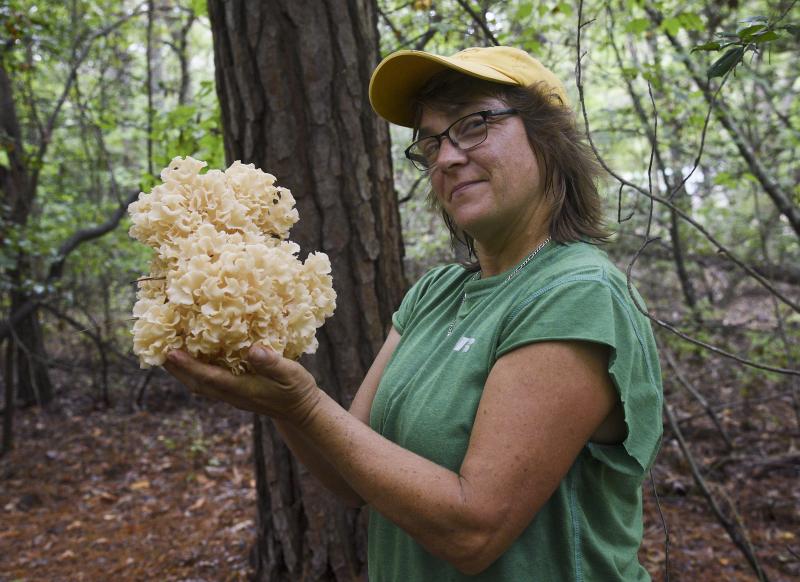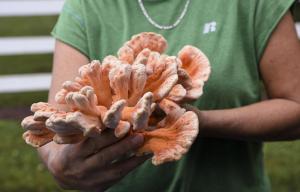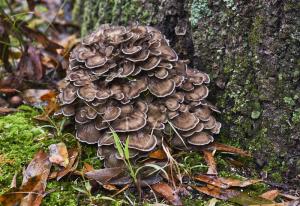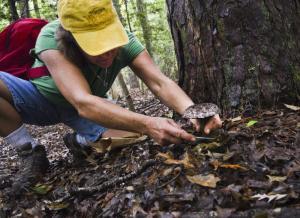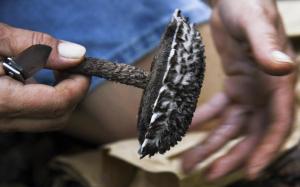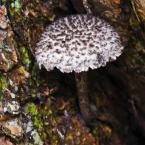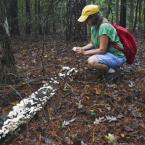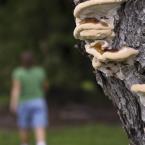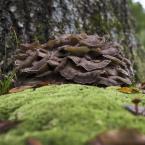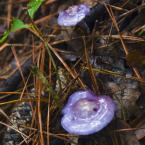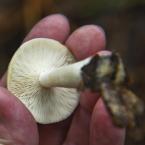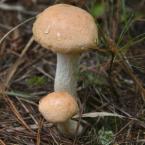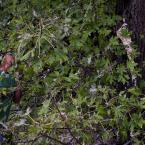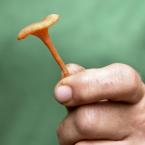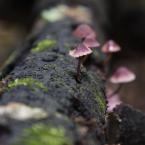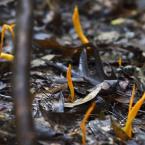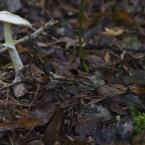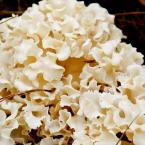Foraging for fungus
Diana Saunders is not only a forager but also a fisherman and chef, cooking with what is fresh and in season. The winter is a difficult time for finding food in the wild, so she makes a sauce of garlic butter and chanterelles and then freezes the sauce to use later, bringing the mushrooms back to make winter meals less dull. “You can dehydrate them, or freeze them, but I prefer fresh,” she said.
But during spring and fall, after a rain, it’s time to hit the road. That’s when conditions are just right for mushrooming, and Diana Saunders is outside, always scanning as she drives. She hunts in shorts and sneakers with a backpack full of paper bags to hold her loot. Her quiet demeanor and sassy smile disguise her hustle to procure a crop of mushrooms.
“It looks like my GPS says there is a hen 8 miles away,” she said. For years, Saunders has plugged in coordinates when she finds a good batch of mushrooms.
Saunders first learned about mushrooms from her fishing buddies, and for 25 years has worked on foraging skills with friends. She takes trips to Maryland, New Jersey, and Pennsylvania, because that is where she can find the highly sought-after morels. “I have not found a morel in Delaware yet. I’m sure they are here somewhere, just not as abundant as other nearby states,” Saunders said.
Last year’s rain was good for Saunders, who last hunted late in October, even though she had already gathered more than 50 pounds of mushrooms.
First up, in a yard beside a busy road, is a shock of bright orange. “Do you see it?” she said. Chicken-of-the-woods mushrooms grow from spring until fall. Saunders judiciously leaves a few behind to allow the spores to reproduce, creating another crop.
Next up is the yard of a friend, who is a chef, who had no clue the mushroom growing on his tree was edible. Now that he knows, he keeps some and still shares with Saunders. Camouflaged on a damp tree, the hen-of-the-woods mushrooms she is after are nestled at the base of what she calls a mother lode tree.
“Every year I try to learn a new mushroom. I started with one, and now I know more than 30.” Depending on the time of year, she finds chanterelles, hens and chickens of the woods, cauliflowers, Reishis, lion’s manes, oysters, old man of the woods and boletes.
“I look for oak trees because usually, that is where you find edible mushrooms,” she said. If she is not sure about something she finds, she will leave it. “In the spring, if I am in Maryland or Pennsylvania, I look for tulip poplar or elm trees because that is where the morels are,” she said. Using her expertise, she can tell if the mushroom is edible by looking at the underside; if it has gills, she leaves it alone.
The bolete has a lot of varieties. This mushroom has an underside that is spongy, not gills like the familiar portabello mushroom. She has seen red, as well as light-and dark-brown boletes. She recalls a red and yellow one that when picked, bruised blue - that one is toxic. But there is one that is close to the same color and is edible. So mushroom hunting can be tricky. Gilled ones are not always edible; they might not be deadly toxic but might just cause gastrointestinal distress. The death cap is a deadly poisonous fungus and should be avoided.
“I mark my GPS when I find a good batch and note the date. I found a chicken-of-the-woods in May and one in September, and they are right next to each other. But there is no way of knowing unless you are there at the right time.” Some varieties just pop up, like a lion’s mane, aka bearded tooth, which she just happened to see while looking for other mushrooms in Pennsylvania.
Saunders picks up a tree limb and begins swinging, saying, “This is a web wand,” as she heads into the Redden Forest. The wand clears her path of spider webs; it also looks like she is casting a spell, calling on mushrooms to appear to her.
The fall forest gave up a lot of edible and inedible varieties. Better left behind were: Indian pipes, orange fungus shaped like a blade of grass, purple ones, and the white, large-as-her-face, umbrella-shaped fungus she chose to put on a glove before handling.
Cutting a large circle through the woods and down a horse path, Saunders discovered reishi mushrooms were abundant. She also found several varieties of boletes and a surprise. While heading out of the forest, Diana quickly turned left and made a beeline for what looked like a plastic bag out of place. She instantly knew what it was, and got a grin on her face. It was a rare parasitic fungus, the cauliflower mushroom. The head looked like a large cauliflower, thus the name, but the leaves are reminiscent of egg noodles and can be used that way.
Early spring is a tough time for Saunders – mushrooms aren’t growing. So she does what she has been doing most of her life; she is hunting asparagus and waiting patiently for warmer weather.














